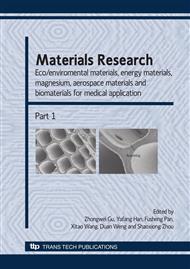p.1113
p.1120
p.1128
p.1132
p.1137
p.1143
p.1150
p.1155
p.1160
Hydroxyapatite Deposition by Alternate Soaking Technique on Poly (Vinyl Alcohol)-Coated Poly (ε-Caprolactone) (PCL) Substrate
Abstract:
Biomineralization on surface-modified poly (ε-caprolactone) (PCL) through an alternate soaking process was investigated. A poly(vinyl alcohol) (PVA)-coating on PCL substrate prepared by repetitive adsorption/ drying in an aqueous PVA solution could accelerate hydroxyapatite (HA) deposition while PVA-PCL soaked in aqueous solutions containing Ca2+ and PO3-4 ions alternately. Fourier transform infrared (FTIR) and X-ray diffraction of the apatite verified the formed hydroxyapatite in these processes exhibited a close resemblance with calcium phosphates (HA, Ca10(PO4)6(OH)2). It was also found that the amount of HA formed increased with both soaking with both soaking cycles and deposition amount of PVA on PCL. This study suggested that simple PVA coating on PCL substrate could serve as a novel way to accelerated HAP formation via alternating soaking.
Info:
Periodical:
Pages:
1137-1142
Citation:
Online since:
January 2009
Authors:
Price:
Сopyright:
© 2009 Trans Tech Publications Ltd. All Rights Reserved
Share:
Citation:


